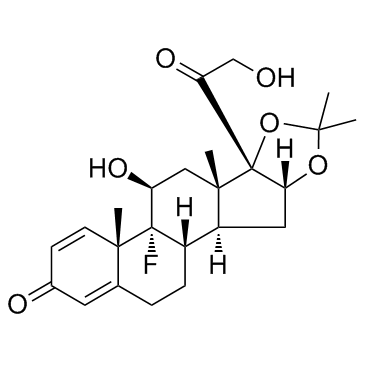The influence of peri-incisional triamcinolone acetonide injection on wound edge apposition.
Carlos K Wesley, Lynn H Y Teo, Tina Xu, Robin H Unger, Walter P Unger
文献索引:J. Dermatolog. Treat. 25(4) , 345-9, (2014)
全文:HTML全文
摘要
Local administration of corticosteroids has been demonstrated to have both beneficial and detrimental effects on wound healing. The advantages of limiting localized edema must be weighed against corticosteroids' disadvantageous inhibition of the normal growth factor profile production that is essential for would healing. A single-center prospective, randomized, controlled, single-blind study of 57 patients undergoing hair restoration surgery (HRS) by one of three different surgeons revealed: 1) no dehiscence along the donor wound; 2) no statistically significant difference (p < 0.05) in wound edge apposition noted between patients receiving or not receiving intralesional corticosteroids at any of the four measured scalp regions and 3) a non-statistically significant trend emerged suggesting the benefit of corticosteroid at the temples (points of decreased donor closing tension) versus its potential hindrance along the mastoids (points of increased tension). These results suggest that peri-incisional triamcinolone acetonide (PITMC) does not have a statistically significant effect on donor wound edge apposition within 8-10 days of HRS. A subtle, though not statistically significant, trend emerged demonstrating the benefit of PITMC with respect to early phase donor wound edge apposition in areas of least donor closing tension and the hindrance of PITMC in regions of increased tension.
相关化合物
| 结构式 | 名称/CAS号 | 分子式 | 全部文献 |
|---|---|---|---|
 |
曲安奈德
CAS:76-25-5 |
C24H31FO6 |
|
Novel Nrf2 activators from microbial transformation products...
2015-03-01 [Br. J. Pharmacol. 172(5) , 1237-49, (2015)] |
|
Evaluation of the reporting level to detect triamcinolone ac...
2015-01-01 [J. Steroid Biochem. Mol. Biol. 145 , 94-102, (2015)] |
|
A general analytical platform and strategy in search for ill...
2014-11-01 [J. Pharm. Biomed. Anal. 100 , 215-29, (2014)] |
|
Detection and characterization of triamcinolone acetonide me...
2014-08-30 [Rapid Commun. Mass Spectrom. 28(16) , 1829-39, (2015)] |
|
Verteporfin therapy and triamcinolone acetonide: convergent ...
2006-01-01 [Eur. J. Ophthalmol. 16(6) , 824-34, (2006)] |